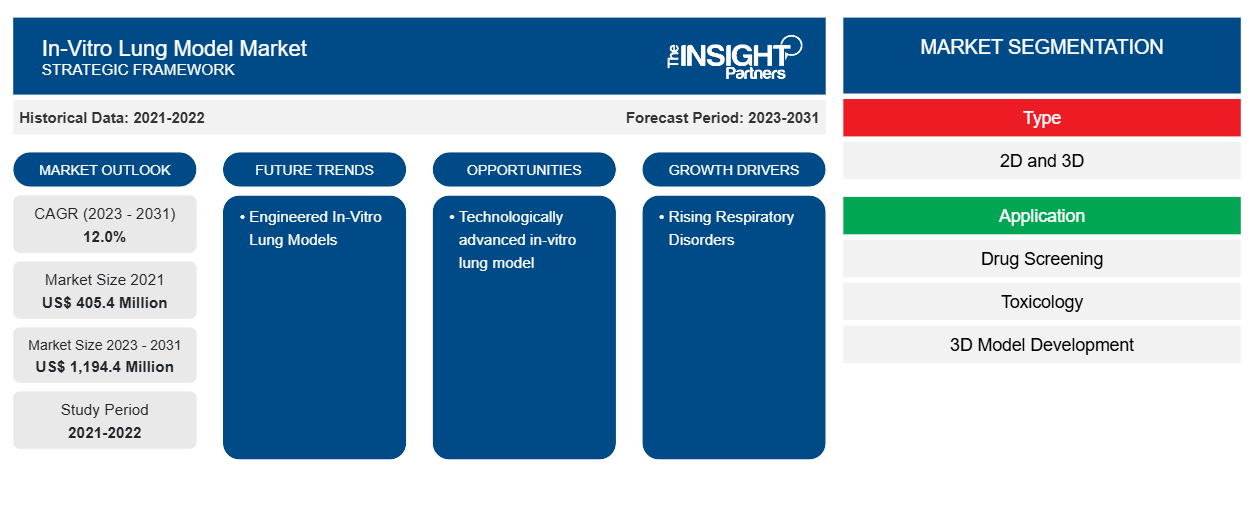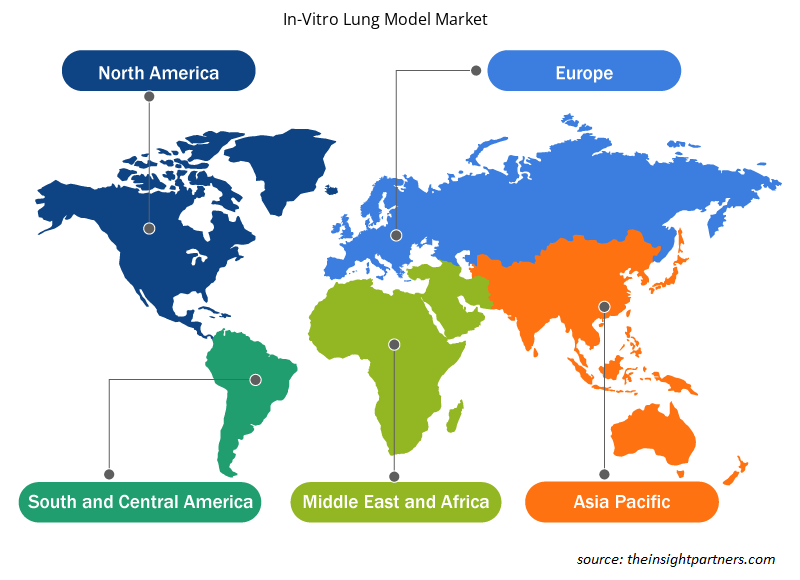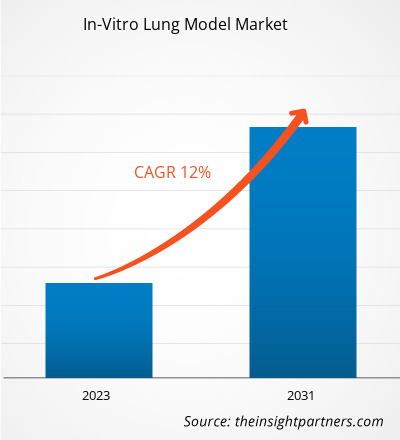Der Markt für In-vitro-Lungenmodelle wird voraussichtlich von 446,35 Millionen US-Dollar im Jahr 2024 auf 1.530,11 Millionen US-Dollar im Jahr 2031 anwachsen. Für den Zeitraum 2025–2031 wird eine durchschnittliche jährliche Wachstumsrate (CAGR) von 19,4 % erwartet. Anwendungen von 3D-Kulturen und KI in der Onkologie dürften in den kommenden Jahren neue Trends auf den Markt bringen.
Marktanalyse für In-vitro-Lungenmodelle
Das Marktwachstum wird durch die zunehmende Verbreitung von Atemwegserkrankungen und die zunehmende Nutzung von In-vitro-Modellen als Alternative zu Tierversuchen vorangetrieben. Präzisionsgeschnittene Lungenschnitte (PCLS) ermöglichen die Untersuchung von Atemwegsverengungen und Entzündungen und erleichtern so die Evaluierung neuer Therapieansätze für Asthma und andere Atemwegserkrankungen. Lungen-on-a-Chip-Geräte wurden entwickelt, um die physiologischen Bedingungen der menschlichen Lunge nachzubilden. Das „Lung-on-a-Chip“-Gerät der University of Michigan nutzt menschliche Lungengewebezellen, die auf einem Kunststoffchip mit mikroskopischen Kanälen kultiviert werden, um die Bedingungen in der Lunge zu simulieren und so neue Erkenntnisse über Krankheiten zu gewinnen. Die steigende Nachfrage nach wirksamen Behandlungen und Forschungsmodellen treibt somit das Wachstum des Marktes für In-vitro-Lungenmodelle voran.
Marktübersicht für In-vitro-Lungenmodelle
Laut Daten der Centers for Disease Control and Prevention (CDC) waren im Jahr 2021 in den USA rund 25 Millionen Menschen von Asthma betroffen. Laut WHO wurden im Jahr 2022 rund 2,5 Millionen Menschen mit Lungenkrebs diagnostiziert, und über 1,8 Millionen Menschen starben an der Krankheit. Laut WHO-Daten betrug die Zahl der gemeldeten Fälle vom Auftreten von COVID-19 Ende 2019 bis April 2023 rund 762 Millionen, mit 6,81 Millionen damit verbundenen Todesfällen. Diese steigende Zahl von Atemwegserkrankungen treibt die Nachfrage nach fortschrittlichen Forschungsmodellen voran, um Krankheitsmechanismen zu verstehen und wirksame Behandlungen zu entwickeln. In-vitro-Lungenmodelle bieten wertvolle Plattformen für die Untersuchung von Krankheitsmechanismen und die Erprobung potenzieller Therapien und unterstützen so die Entwicklung wirksamer Behandlungen.
Sie erhalten kostenlos Anpassungen an jedem Bericht, einschließlich Teilen dieses Berichts oder einer Analyse auf Länderebene, eines Excel-Datenpakets sowie tolle Angebote und Rabatte für Start-ups und Universitäten
Markt für In-vitro-Lungenmodelle: Strategische Einblicke

-
Informieren Sie sich über die wichtigsten Markttrends in diesem Bericht.Dieses KOSTENLOSE Beispiel umfasst Datenanalysen, von Markttrends bis hin zu Schätzungen und Prognosen.
Markttreiber und Chancen für In-vitro-Lungenmodelle
Zunehmende Nutzung von In-vitro-Modellen als Alternative zu Tierversuchen
In-vitro-Lungenmodelle bieten eine Alternative zu Tierversuchen und ermöglichen es Forschern, die Biologie und Erkrankungen der menschlichen Lunge präziser und relevanter zu untersuchen. Diese In-vitro-Modelle bilden die Alveolen, Atemwege, Gefäße, das Mesothel und das Interstitium des nativen Lungengewebes genau nach. Ihre multizelluläre Zusammensetzung ermöglicht eine genaue Simulation der räumlichen und funktionellen Dynamik der Lunge in situ, was sie zu einem unverzichtbaren Instrument in der biomedizinischen Forschung macht. Daher setzen Forscher Lungenmodelle heute für eine breite Palette von Anwendungen ein, von der Krankheitsmodellierung über die Toxikologie bis hin zur Arzneimittelentwicklung. Der Innovationszuschuss 2021 förderte die Entwicklung eines synthetischen Lungenmodells an der University of Reading. Der Gewinner, Dr. Hisham Al-Obaidi, und sein Team an der University of Reading erhielten 2021 einen Innovationszuschuss in Höhe von 8.692,19 US-Dollar (6.500 GBP) für die Entwicklung eines synthetischen Lungenmodells, das Tierversuche ersetzen soll. Das Projekt konzentriert sich auf die Entwicklung eines In-vitro-Lungenmodells zur Bewertung der Wirksamkeit antimikrobieller Wirkstoffe. Ziel ist es, ein In-vitro-Modell zu entwickeln, das die menschliche Lunge im Vergleich zu herkömmlichen tierbasierten Methoden nachahmt. Das Team entschied sich für ein nicht-biologisches Modell, das das Verhalten von Medikamenten im menschlichen Atmungssystem simuliert. Ihr Ansatz zeigte, dass das getestete Medikament tief in die lungenähnliche Struktur eindringen, eine Schleim simulierende Hydrogelschicht passieren und Bakterien eliminieren konnte. Derzeit validiert das Team das Modell. Dabei wird die Wirkung inhalierter Antibiotikapartikel auf reife Bakterienkolonien auf Agarplatten getestet, um festzustellen, ob nach der Behandlung lebensfähige Bakterien verbleiben. Dieses Modell könnte ein wertvolles Instrument zur Vorhersage der antimikrobiellen Wirksamkeit beim Menschen sein und gleichzeitig die Abhängigkeit von Tierversuchen reduzieren.
Steigende Finanzierung und Investitionen für In-vitro-Modelle
In-vitro-Lungenmodelle bieten genauere Simulationen der menschlichen Lungenphysiologie als herkömmliche 2D-Kulturen. Dieser Fortschritt hat Investitionen aus dem öffentlichen und privaten Sektor angezogen. Emulate, ein auf Organ-on-Chip-Technologie spezialisiertes Biotechnologieunternehmen, hat Investitionen angezogen, um menschliche zellbasierte Modelle zu kommerzialisieren, die Funktionen auf Organebene nachbilden. Im September 2021 sammelte Emulate in einer vom Founders Fund angeführten Finanzierungsrunde der Serie E 82 Millionen US-Dollar ein und unterstreicht damit das Vertrauen in Organ-on-Chip-Plattformen für Arzneimitteltests und Krankheitsmodellierung. Im Dezember 2024 sicherte sich Newcells Biotech, ein britisches Biotech-Startup, das auf die Entwicklung fortschrittlicher In-vitro-Modelle für die Arzneimittelforschung spezialisiert ist, eine Finanzierung von 1,60 Millionen US-Dollar (1,2 Millionen Pfund) von Mercia Ventures, Northstar Ventures und North East Finance. Newcells wurde 2015 als Spin-off der Newcastle University gegründet und entwickelt 3D-Gewebemodelle, die Netzhaut, Niere und Lunge nachbilden. Diese Modelle werden verwendet, um die Sicherheit und Wirksamkeit von Medikamenten vorherzusagen. Die Finanzierung ermöglicht es Newcells, seinen Kundenstamm zu erweitern, neue Partnerschaften einzugehen und sein Angebot in wichtigen internationalen Märkten zu verbessern. Dadurch fördern solche Finanzierungen und Investitionen die Entwicklung wirksamerer Behandlungen für Atemwegserkrankungen und bieten vielversprechende Zukunftschancen für Unternehmen im Gesundheits- und Biotechnologiesektor.
Segmentierungsanalyse des Marktberichts „In-vitro-Lungenmodelle“
Wichtige Segmente, die zur Ableitung der Marktanalyse für In-vitro-Lungenmodelle beigetragen haben , sind Technologie, Tierart, Verabreichungsweg, Endbenutzer und Geografie.
- Der Markt für In-vitro-Lungenmodelle unterteilt sich nach Typ in 3D- und 2D-Modelle. Das 3D-Modell hatte 2024 den größten Anteil am Markt für In-vitro-Lungenmodelle und wird zwischen 2025 und 2031 voraussichtlich eine signifikante jährliche Wachstumsrate verzeichnen.
- Nach Anwendung wird der Markt in Arzneimittelforschung und toxikologische Studien, physiologische Forschung, regenerative Medizin und andere unterteilt. Das Segment Arzneimittelforschung und toxikologische Studien hielt im Jahr 2024 den größten Anteil am Markt für In-vitro-Lungenmodelle.
- Der Markt für In-vitro-Lungenmodelle ist hinsichtlich der Endnutzer in Pharma- und Biotechnologieunternehmen, Hochschulen und Forschungsinstitute sowie weitere Unternehmen segmentiert. Das Segment der Pharma- und Biotechnologieunternehmen hielt 2024 den größten Anteil am Markt für In-vitro-Lungenmodelle und wird zwischen 2025 und 2031 voraussichtlich eine signifikante jährliche Wachstumsrate verzeichnen.
In-vitro-Lungenmodelle Marktanteilsanalyse nach Geografie
Der geografische Umfang des Marktberichts für In-vitro-Lungenmodelle ist hauptsächlich in fünf Hauptregionen unterteilt: Nordamerika, Europa, Asien-Pazifik, Naher Osten und Afrika sowie Süd- und Mittelamerika. Nordamerika dominierte den Markt im Jahr 2024. Technologische Innovationen und eine starke biomedizinische Forschungsinfrastruktur tragen zum Wachstum des nordamerikanischen Marktes bei. Technologische Innovationen haben maßgeblich zur Verbesserung der Komplexität und Funktionalität von In-vitro-Modellen beigetragen. Fortschritte in den Bereichen Tissue Engineering, Mikrofluidik und Organ-on-a-Chip-Technologien haben die Entwicklung präziserer und prädiktiverer Modelle für die Arzneimittelforschung und toxikologische Studien ermöglicht. Diese Innovationen erleichtern die Erstellung von Modellen, die die menschliche Lungenphysiologie genau nachbilden, die Zuverlässigkeit präklinischer Tests verbessern und den Bedarf an Tierversuchen reduzieren.
Die Region beherbergt führende akademische Einrichtungen, Forschungsorganisationen und Pharmaunternehmen, die in der In-vitro-Lungenmodellforschung führend sind. Diese Einrichtungen verfügen über modernste Einrichtungen, Spitzentechnologien und qualifizierte Forscher, die es ihnen ermöglichen, Innovationen voranzutreiben und das Feld zu erweitern. Das Marktwachstum wird zudem durch die Präsenz wichtiger Branchenakteure, den Ausbau von Tierschutzprogrammen und -vorschriften sowie eine gut etablierte Gesundheitsinfrastruktur vorangetrieben. Fördernde staatliche Initiativen und eine steigende Zahl von Forschungskooperationen fördern das Wachstum des Marktes für In-vitro-Lungenmodelle zusätzlich.
Regionale Einblicke in den Markt für In-vitro-Lungenmodelle
Die Analysten von Insight Partners haben die regionalen Trends und Faktoren, die den Markt für In-vitro-Lungenmodelle im Prognosezeitraum beeinflussen, ausführlich erläutert. Dieser Abschnitt behandelt auch die Marktsegmente und die geografische Lage für In-vitro-Lungenmodelle in Nordamerika, Europa, Asien-Pazifik, dem Nahen Osten und Afrika sowie Süd- und Mittelamerika.

- Erhalten Sie regionale Daten zum Markt für In-vitro-Lungenmodelle
Umfang des Marktberichts über In-vitro-Lungenmodelle
| Berichtsattribut | Details |
|---|---|
| Marktgröße im Jahr 2024 | 446,35 Millionen US-Dollar |
| Marktgröße bis 2031 | 1.530,11 Millionen US-Dollar |
| Globale CAGR (2025 – 2031) | 19,4 % |
| Historische Daten | 2021-2023 |
| Prognosezeitraum | 2025–2031 |
| Abgedeckte Segmente |
Nach Typ
|
| Abgedeckte Regionen und Länder |
Nordamerika
|
| Marktführer und wichtige Unternehmensprofile |
|
Marktteilnehmerdichte für In-vitro-Lungenmodelle: Auswirkungen auf die Geschäftsdynamik
Der Markt für In-vitro-Lungenmodelle wächst rasant. Dies wird durch die steigende Endverbrauchernachfrage aufgrund veränderter Verbraucherpräferenzen, technologischer Fortschritte und eines stärkeren Bewusstseins für die Produktvorteile vorangetrieben. Mit der steigenden Nachfrage erweitern Unternehmen ihr Angebot, entwickeln Innovationen, um den Verbraucherbedürfnissen gerecht zu werden, und nutzen neue Trends, was das Marktwachstum weiter ankurbelt.
Die Marktteilnehmerdichte beschreibt die Verteilung der in einem bestimmten Markt oder einer bestimmten Branche tätigen Unternehmen. Sie gibt an, wie viele Wettbewerber (Marktteilnehmer) in einem bestimmten Marktraum im Verhältnis zu dessen Größe oder Gesamtmarktwert präsent sind.
Die wichtigsten Unternehmen, die auf dem Markt für In-vitro-Lungenmodelle tätig sind, sind:
- MatTek Corp
- Lonza Group AG
- Emulate, Inc
- CN Bio Innovations Ltd
- PromoCell GmbH
- Charles River Laboratories International Inc
Haftungsausschluss : Die oben aufgeführten Unternehmen sind nicht in einer bestimmten Reihenfolge aufgeführt.

- Überblick über die wichtigsten Akteure auf dem Markt für In-vitro-Lungenmodelle
Marktnachrichten und aktuelle Entwicklungen zu In-vitro-Lungenmodellen
Der Markt für In-vitro-Lungenmodelle wird durch die Erhebung qualitativer und quantitativer Daten aus Primär- und Sekundärforschung bewertet, die wichtige Unternehmenspublikationen, Verbandsdaten und Datenbanken einbeziehen. Die wichtigsten Marktentwicklungen sind nachstehend aufgeführt:
- Emulate, Inc., Anbieter von In-vitro-Modellen der nächsten Generation, begrüßte den kürzlich angekündigten Plan der US-amerikanischen Food and Drug Administration (FDA), die Abhängigkeit von Tierversuchen in präklinischen Sicherheitsstudien zu reduzieren. Der strategische Fahrplan der FDA skizziert, wie neue Methoden (New Approach Methodologies, NAMs), darunter Organchips, fortschrittliche computergestützte Modellierung und andere In-vitro-Tests, dazu beitragen werden, die Arzneimittelentwicklung zu optimieren, Kosten zu senken und die Patientensicherheit zu verbessern. (Quelle: Emulate Inc., Unternehmenswebsite, April 2025)
- Lonza, ein globaler Produktionspartner für die Pharma-, Biotech- und Nutraceutikamärkte, gab heute die Unterzeichnung einer Vereinbarung zur Übernahme des Genentech-Standorts für die großtechnische Produktion von Biologika in Vacaville, Kalifornien (USA), von Roche für 1,2 Milliarden US-Dollar bekannt. (Quelle: Lonza, Unternehmenswebsite, März 2025).
Marktbericht zu In-vitro-Lungenmodellen: Umfang und Ergebnisse
Der Bericht „Marktgröße und Prognose für In-vitro-Lungenmodelle (2021–2031)“ bietet eine detaillierte Analyse des Marktes, die die folgenden Bereiche abdeckt:
- In-vitro-Lungenmodelle Marktgröße und Prognose auf globaler, regionaler und Länderebene für alle wichtigen Marktsegmente, die im Rahmen des Geltungsbereichs abgedeckt sind
- Markttrends für In-vitro-Lungenmodelle sowie Marktdynamiken wie Treiber, Einschränkungen und wichtige Chancen
- Detaillierte PEST- und SWOT-Analyse
- Marktanalyse für In-vitro-Lungenmodelle, die wichtige Markttrends, globale und regionale Rahmenbedingungen, wichtige Akteure, Vorschriften und aktuelle Marktentwicklungen umfasst
- Branchenlandschafts- und Wettbewerbsanalyse mit Marktkonzentration, Heatmap-Analyse, prominenten Akteuren und jüngsten Entwicklungen für den Markt für In-vitro-Lungenmodelle
- Detaillierte Firmenprofile
- Historische Analyse (2 Jahre), Basisjahr, Prognose (7 Jahre) mit CAGR
- PEST- und SWOT-Analyse
- Marktgröße Wert/Volumen – Global, Regional, Land
- Branchen- und Wettbewerbslandschaft
- Excel-Datensatz
Aktuelle Berichte
Erfahrungsberichte
Grund zum Kauf
- Fundierte Entscheidungsfindung
- Marktdynamik verstehen
- Wettbewerbsanalyse
- Kundeneinblicke
- Marktprognosen
- Risikominimierung
- Strategische Planung
- Investitionsbegründung
- Identifizierung neuer Märkte
- Verbesserung von Marketingstrategien
- Steigerung der Betriebseffizienz
- Anpassung an regulatorische Trends






















 Kostenlose Probe anfordern für - Markt für In-vitro-Lungenmodelle
Kostenlose Probe anfordern für - Markt für In-vitro-Lungenmodelle